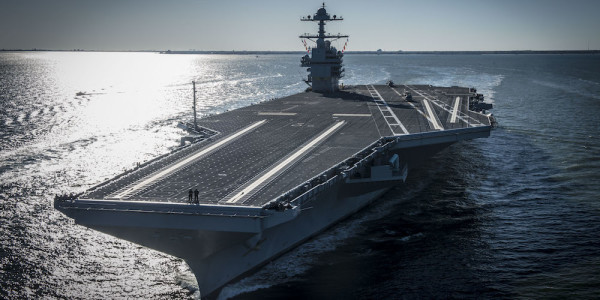

The Department of Defense’s fiscal year 2019 budget includes a hefty chunk of cash for a fourth Ford-class aircraft carrier, but the Navy may have to wait a little bit longer to see its dreams of an 11-carrier fleet truly realized.
Among the slew of vessels included in the Navy portion of President Donald Trump’s planned boost to the U.S. armed forces budget are three Arleigh Burke-class destroyers, two Virginia-class submarines, and the “first year of full funding” for the now-unnamed CVN 81 aircraft carrier, a younger sibling to the brand-new $13 billion USS Gerald R. Ford (CVN 78), which the Navy (and Trump) commissioned last July.
But as it turns out, the Pentagon’s latest technical assessment of the next-generation (and urinal-less) supercarrier reveals a warship currently incapable of performing basic functions during routine operations; the service on Feb. 7 reportedly appealed to Secretary of Defense James Mattis to delay critical shock testing of the new carriers until the second Ford-class hull, USS John F. Kennedy, comes available in 2024 — the same stress-testing for which lawmakers let the Navy off the hook in June 2017.
The DoD’s intensive assessment of the Ford, conducted by the Office of the Director of Operational Test and Evaluation and published last month, along with its other 2017 technical analyses, reveals “poor or unknown reliability” among many of the Ford’s essential systems, including newly designed catapults, arresting gear, weapons elevators, and radar.”
These systems aren’t just high-profile (see: that steamless catapult) but critical for the vessel’s roles in counterterrorism and great-power deterrence. “[The limitations] could affect the ability of CVN 78 to generate sorties, make the ship more vulnerable to attack, or create limitations during routine operations,” the report states. “The poor or unknown reliability of these critical subsystems is the most significant risk to CVN 78.”
Among the most glaring problems facing the vessel: those “goddamned” electromagnetic catapults. While the Boeing F/A-18F Super Hornet and EA-18G Growler aircraft experienced “excessive airframe stress” on launches, according to the DoD report, the Navy also “identified an inability to readily electrically isolate Electromagnetic Aircraft Launching System (EMALS) and Advanced Arresting Gear (AAG) components to perform maintenance” — a complication that means sailors could find themselves unable to perform underway maintenance or repairs on one of the ship’s most critical systems.
This isn’t just real pain in the ass when something goes wrong during a sustained bombing campaign against, say, forces hostile to U.S personnel downrange in Syria: It renders the whole system functionally useless. At the current reliability, Ford’s cats only have “a 9 percent chance of completing the 4-day surge and a 70 percent chance of completing a day of sustained operations as defined in the design reference mission without a critical failure.” That’s on a good day, with a deck full of trained-up sailors; the Ford class was designed to reduce manning requirements but is “sensitive to manpower fluctuations” simply because the next-generation technologies it embraces “are not well understood,” the report states
More concerning are the shock tests the Navy is delaying on the Ford, in which light charges would be set off in the water around the ship to test its systems’ reliance under stress. In recent years, DoD regulations stipulated that Full Ship Shock Trials, designed to test hull resiliency, are should be conducted at “two-thirds of the shock level that ships are required to survive”; the service’s push to delay even such nominal tests raises questions about officials’ confidence in their new supercarrier.
On the upside, Trump’s 2019 defense budget request contains around $1.8 billion for the “continued development” of Ford-class carrier technologies, as Defense News put it on Feb. 13. A few billion here, a few billion there — pretty soon, we’ll be talking about a working aircraft carrier.
Want to read more from Task & Purpose? Sign up for our daily newsletter »